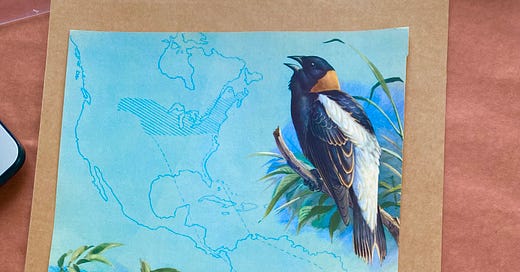I’ve been here in The Lung for almost 20 years now. The time has flown. Nature is still as mysterious as ever.
I take such joy in simple things like the return of the many species of flycatchers that come back year after year. I say “simple” like an arrogant human, but it’s not simple at all. Every spring is different. So far the constants are the paper wasps, flycatchers, robins and bluebirds, and kestrels. There are species I don’t see anymore that I used to take for granted – the bobolink is one.
I leave my fields un-mown long into mid-summer, after the babies have fledged and flown, even if I don’t actually see one. GMO farming intensity, chemical use, and earlier season harvesting of hay has taken a huge toll on these little guys. They have seen a 75% decline in Vermont between 1966 and 2007. That is a MAJOR blow. They are one of the most beautiful little birds you’ll ever see and their call is very distinct. I am holding out hope that they can come back like the monarch butterfly seems to be here in northeastern Vermont. A farm here without a splendid little bobolink flitting along the fenceline doesn’t seem like a Vermont farm.
They live like little long-haul truckers; some even have more than one family at a time! They winter in South America, then migrate back to the Northeastern United States and Southeastern Canada through places like Jamaica, The Galapagos and the Carolinas. They feed heavily on grains while migrating but also the destructive armyworm; they eat so many armyworm moths they are sometimes called the “Armyworm Bird” in the South. I chose that article I linked to about the armyworm on purpose. The article has good info, but, more importantly, it lists the chemicals used to control this insect – SO many chemicals, all “cautioned” or “restricted” because they are so poisonous. The long and short of it is we need more friends like the bobolink and fewer poisons. (And as much as we don’t want to admit it, we even need the armyworm.)
When migrating, bobolinks can travel as many as 1,100 miles IN A DAY! Needless to say, by the time they get to my house they are ready to settle down and start a family (or three) and get down to eating bugs and seeds with a vengeance. Sadly, I haven’t seen a bobolink in about seven or eight years. I’m not a scientist, obviously, but I am a chronic “noticer” here in The Lung and to me the bobolink’s absence is stark. I am not giving up though. I hadn’t seen a monarch butterfly in forever either, but for every year I don’t cut the milkweed and just let it thrive, more and more butterflies show up! So please, think your kindest thoughts about the bobolink and let me end with a very hopeful article about the Yurok Tribe and condors by Tiana Williams-Claussen. Thank you, Tiana! This was the fuel I needed. XO
Bobolink drawing by Walter Alois Weber






I'm definitely going to read these articles, but I just wanted to say that some of the most important works for conservation were not produced by scientists. John Muir, Margory Stoneman Douglass, even Jane Goodall, were not trained in the sciences. They just had a love for nature and were able to communicate it's usefulness. I'm sure there were more people who are like this that I just can't think of right now. Even the campaign to create the NPS was mostly done through photography, and Muir contributed through his books. Art & writing have been just as influential in conservation as anything from academia. Just saying that cause I want you to know you are doing the things 🐦🦆🦅🦉💚🤎 just in case you don't recognize it (and if you do then even better!).
Some good news! https://www.adventure-journal.com/2022/04/the-extinct-ivory-billed-woodpecker-not-extinct-after-all/